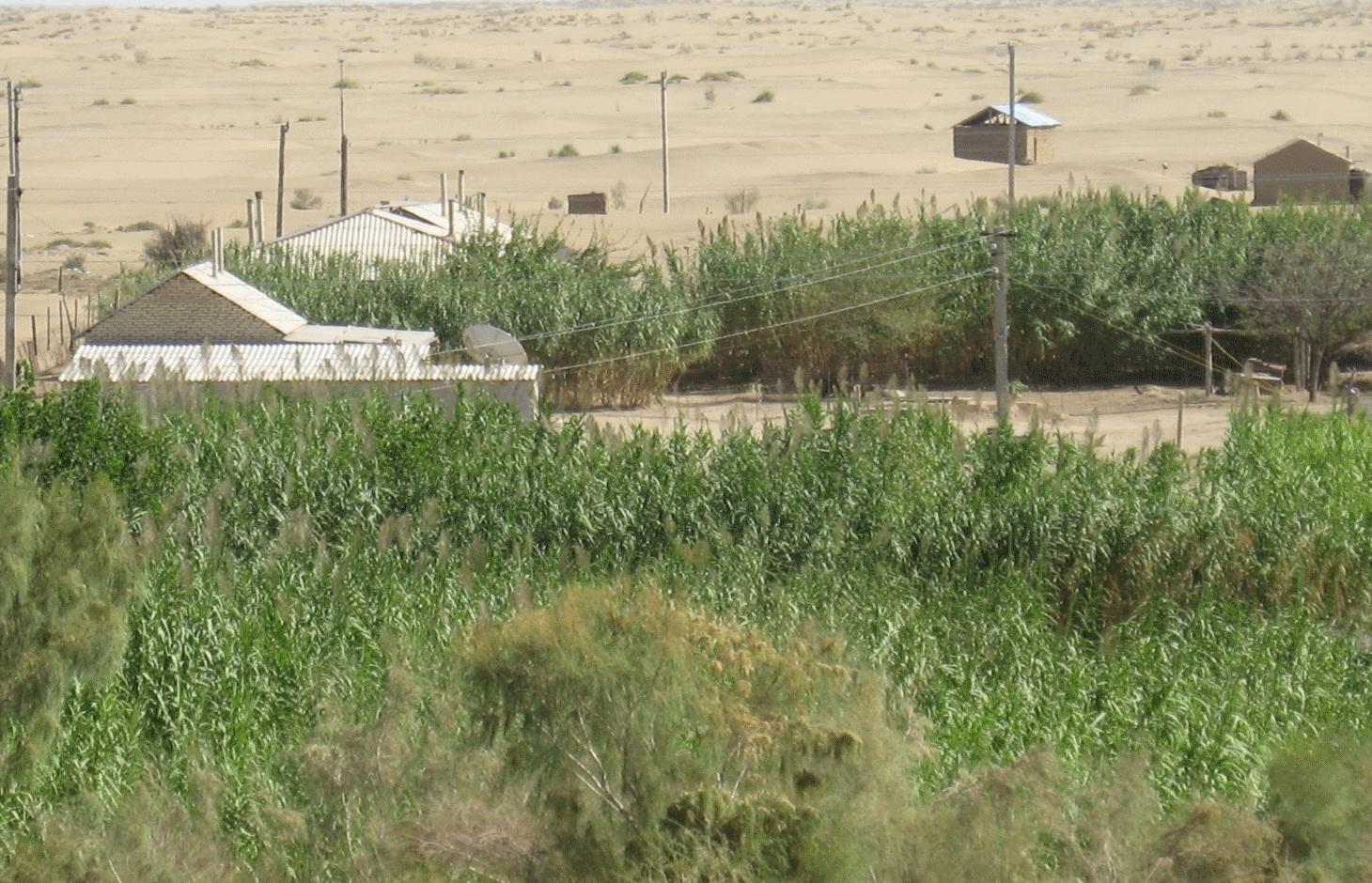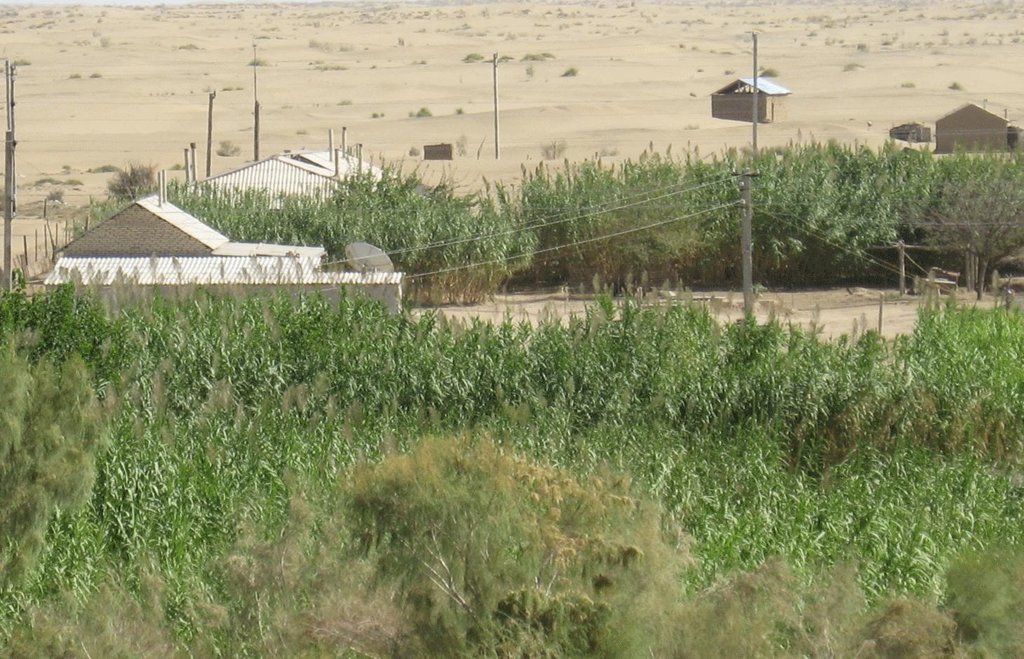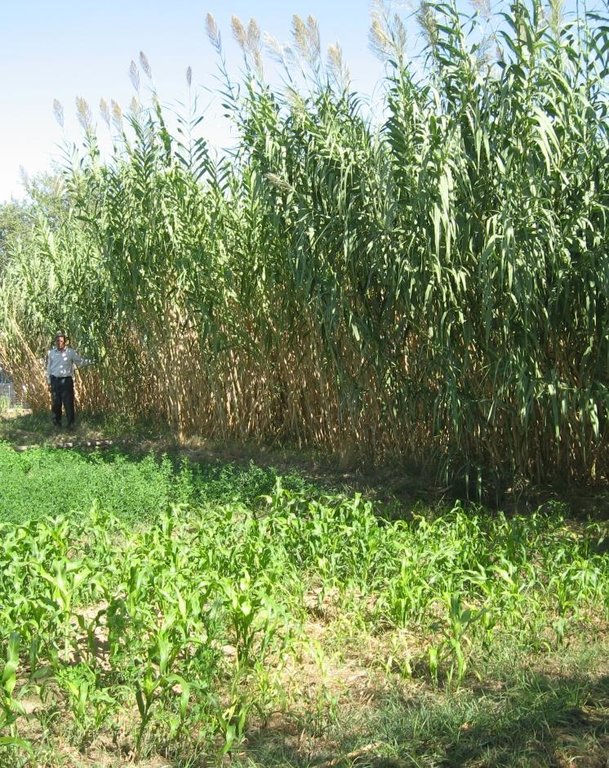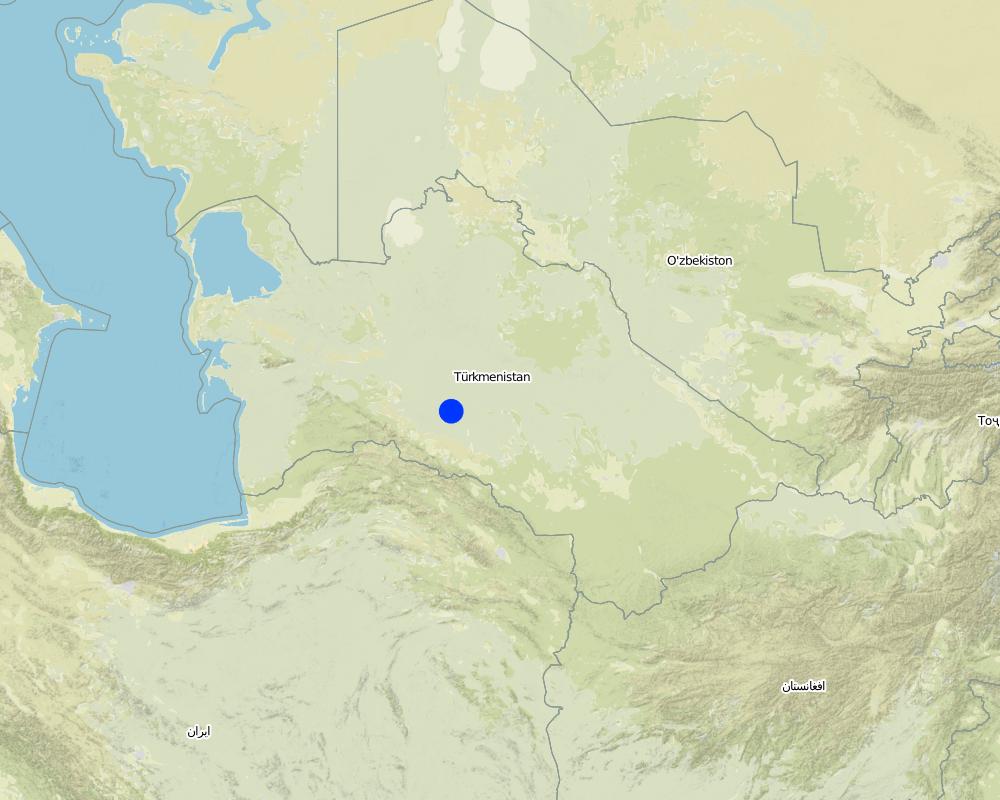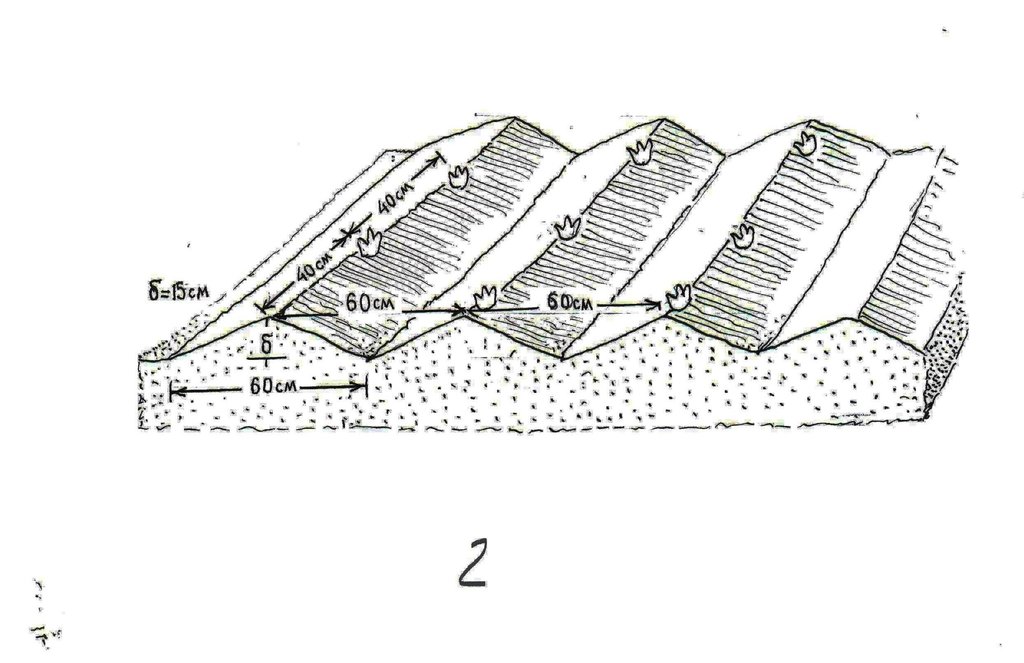Growing Arundo reeds (Arundo donax L.) to create buffer zones around households (CACILM) [Turkmenistan]
- Creation:
- Update:
- Compiler: Nikolay Zverev
- Editor: –
- Reviewers: David Streiff, Alexandra Gavilano
Turkmenistan - Central Asian Countries Initiative for Land Management (CACILM/ИСЦАУЗР)
technologies_1531 - Turkmenistan
- Full summary as PDF
- Full summary as PDF for print
- Full summary in the browser
- Full summary (unformatted)
- Growing Arundo reeds (Arundo donax L.) to create buffer zones around households (CACILM): June 6, 2017 (inactive)
- Growing Arundo reeds (Arundo donax L.) to create buffer zones around households (CACILM): Aug. 7, 2017 (inactive)
- Growing Arundo reeds (Arundo donax L.) to create buffer zones around households (CACILM): Aug. 7, 2019 (public)
View sections
Expand all Collapse all1. General information
1.2 Contact details of resource persons and institutions involved in the assessment and documentation of the Technology
land user:
Baysakhatov Kakabay
24-74-06
Farmer cultivating Arundo in the Bokurdak village
Turkmenistan
Name of project which facilitated the documentation/ evaluation of the Technology (if relevant)
Central Asian Countries Initiative for Land Management (CACILM I)Name of the institution(s) which facilitated the documentation/ evaluation of the Technology (if relevant)
The National Institute of Deserts, Flora and Fauna of the Ministry of Nature Protection of Turkmenistan ( NIDFF) - Turkmenistan1.3 Conditions regarding the use of data documented through WOCAT
When were the data compiled (in the field)?
10/11/2011
The compiler and key resource person(s) accept the conditions regarding the use of data documented through WOCAT:
Yes
2. Description of the SLM Technology
2.1 Short description of the Technology
Definition of the Technology:
Farming techniques for growing arundo reeds in order to protect households from wind and dust and other economic purposes.
2.2 Detailed description of the Technology
Description:
The Arundo reed (Arundo donax) is a 3-4 m tall perennial grass species. It grows wild in Central and South-West Kopetdag on river banks and as a cultivated plant in the gardens of rural areas of Turkmenistan, where it is grown with limited irrigation for economic purposes. Up to 200 t/ha of stems could be harvested. The growing technique is simple. One-off costs for planting Arundo will bring benefits to a farmer for at least 60 years without any additional costs. In the wild and on farmlands, the roots of arundo grow horizontally and in the fall they develop large growth buds in the form of a cone 0.03 m in height and 0.05 m in diameter. In the spring, these buds form above-ground sprouts. To plant the reeds, the roots together with the growth buds should be dug out from the wet soil and cut off with the pruning shears, so that each rootstock has a growth bud. The reeds are then planted in 3-8 m wide belts around the house (150-400m²). In autumn and winter, the planting area is fenced with an earth mound 25x25cm in height and filled with water. Then the land levelling takes place. The soil is spaded to a depth of 20cm, harrowed and planting furrows 15m in height are formed at with 60cm between each row. The area should then be fenced to keep out animals. The rootstocks and growth buds, prepared in advance, are planted perpendicular to the surface of the planting holes in furrows 0.4 m apart and covered with soil. Watering in the 1st year is carried out once every 8 days, and in subsequent years every 15 days.
Purpose of the Technology: The purpose of this technology is to protect farmers’ households from hot, dry winds and dust and to improve environmental conditions and economic livelihood of villagers living in the extremely hot conditions of the Karakum desert
Establishment / maintenance activities and inputs: Bokurdak village is a pilot village for the GIA project. Stages of implementation: 1) establish a public committee during the villagers’ meeting; 2) conduct a workshop to demonstrate the arundo planting techniques at the pilot plot and train local people and authorities; 3) provide financial assistance to 5 households who have expressed an interest in growing arundo with the aim to involve more people and demonstrate the effect of the technology. Currently, the number of farmers growing Arundo has increased to 40 households
Natural / human environment: Bokurdak village, the administrative center of “Karakum” Daikhans’ Association (DA), is located 90 km north of Ashkhabad in the Central Karakum Desert. The village has a population of 4,200 people and is equipped with a school and hospital. It is supplied with water piped from the Karakum Canal, using for irrigation and the watering of animals. Relief: honeycombed sand ridges with takyrs between them. The water table is located at a depth of 18-25 m. Soil types: sandy deserts, takyr-like soils and typical takyrs and solonchaks. Perennial forage grasses and spring annuals grow on natural pastures. Summer is continental, dry and hot, and winters are cold. Precipitation is 141 mm/year.
2.3 Photos of the Technology
2.5 Country/ region/ locations where the Technology has been applied and which are covered by this assessment
Country:
Turkmenistan
Region/ State/ Province:
Turkmenistan, Akhal velayat
Further specification of location:
Ruhabadsky etrap
Map
×2.6 Date of implementation
If precise year is not known, indicate approximate date:
- less than 10 years ago (recently)
2.7 Introduction of the Technology
Specify how the Technology was introduced:
- through projects/ external interventions
Comments (type of project, etc.):
Arundo has long been cultivated in the oases of Turkmenistan, but this is the first time it is grown in this particular climate zone
3. Classification of the SLM Technology
3.1 Main purpose(s) of the Technology
- reduce, prevent, restore land degradation
- reduce risk of disasters
- create beneficial economic impact
3.2 Current land use type(s) where the Technology is applied

Cropland
- Perennial (non-woody) cropping
Main crops (cash and food crops):
major cash crop: Arundo donax
Comments:
Major land use problems (compiler’s opinion): Local vegetation has been completely removed and this has led to the formation of sand dunes around the village. Irrigation water shortage (water is delivered to the village by a 90 km long water pipe). High temperatures in summer and low temperatures in winter, winds, dust storms, heavy clay and loamy soils with a low organic matter content
Major land use problems (land users’ perception): There is a lack of time for work in the gardens, because people spend a lot of time out of the houses with their grazing animals. Not everyone has irrigation water.
Future (final) land use (after implementation of SLM Technology): Cropland: Cp: Perennial (non-woody) cropping
If land use has changed due to the implementation of the Technology, indicate land use before implementation of the Technology:
Other: Oo: Other: wastelands, deserts, glaciers, swamps, recreation areas, etc
3.3 Further information about land use
Water supply for the land on which the Technology is applied:
- full irrigation
Number of growing seasons per year:
- 1
Specify:
Longest growing period in days: 235; Longest growing period from month to month: late March - Mid-November
3.4 SLM group to which the Technology belongs
- windbreak/ shelterbelt
- area closure (stop use, support restoration)
- improved ground/ vegetation cover
3.5 Spread of the Technology
Specify the spread of the Technology:
- evenly spread over an area
If the Technology is evenly spread over an area, indicate approximate area covered:
- < 0.1 km2 (10 ha)
Comments:
Total area covered by the SLM Technology is 0.01 km2.
Region (oblast) – velayat, district - etrap
3.6 SLM measures comprising the Technology

vegetative measures
- V2: Grasses and perennial herbaceous plants
- V5: Others

management measures
- M1: Change of land use type
- M3: Layout according to natural and human environment
- M4: Major change in timing of activities
- M7: Others
Comments:
Secondary measures: management measures
3.7 Main types of land degradation addressed by the Technology

soil erosion by wind
- Eo: offsite degradation effects

biological degradation
- Bc: reduction of vegetation cover
- Bq: quantity/ biomass decline
- Bs: quality and species composition/ diversity decline
- Bl: loss of soil life
Comments:
Main type of degradation addressed: Eo: offsite degradation effects, Bc: reduction of vegetation cover, Bq: quantity / biomass decline, Bs: quality and species composition /diversity decline, Bl: loss of soil life
Main causes of degradation: overgrazing (Excessive use of pastures. Water shortages do not allow the growth of enough plants for a secure fodder reserve)
Secondary causes of degradation: over-exploitation of vegetation for domestic use (Deforestation has destroyed the natural vegetation and increased soil exposure), education, access to knowledge and support services (Poor knowledge and attitudes of stock-breeders constrain the adequate development of crop production in the village. There is no advisory service in the village that could assist in crop growing), Irrigation water scarcity (Not all households have irrigation water due to its scarcity)
3.8 Prevention, reduction, or restoration of land degradation
Specify the goal of the Technology with regard to land degradation:
- restore/ rehabilitate severely degraded land
Comments:
Secondary goals: prevention of land degradation, mitigation / reduction of land degradation
4. Technical specifications, implementation activities, inputs, and costs
4.1 Technical drawing of the Technology
4.2 Technical specifications/ explanations of technical drawing
Planting Arundo donax in the furrows
Location: Bokurdok village. Turkmenistan, Akhal velayat, Ruhabadsky etrap
Date: 2011-10-25
Technical knowledge required for field staff / advisors: moderate (One-time consultation (demonstrating the materials and the planting system))
Technical knowledge required for land users: low
Main technical functions: Arundo stems can be used as building material
Secondary technical functions: increase in organic matter, reduction in wind speed, promotion of vegetation species and varieties (quality, eg palatable fodder)
Vegetative measure: Ridges for planting and irrigation in 0.15 m heigh
Vegetative material: C : perennial crops
Number of plants per (ha): 41750
Spacing between rows / strips / blocks (m): 0.6
Vertical interval within rows / strips / blocks (m): 0.4
Vegetative measure: Vegetative material: C : perennial crops
Vegetative measure: Vegetative material: C : perennial crops
Vegetative measure: Vegetative material: C : perennial crops
Perennial crops species: The perennial species, Arundo reed (Arundo donax L.), has been planted
Change of land use type: The land plot is fenced and guarded to prevent grazing
Change of land use practices / intensity level: A previously unused land plot sustains its biological productivity for 60 years
Layout change according to natural and human environment: Arundo reeds planted around the households improve both the living conditions and microclimate of the households and provide farmers with building materials
Other type of management: Distribution of the species in the village:5 farmers began to grow arundo, and now more than 40 households are engaged in growing arundo
4.3 General information regarding the calculation of inputs and costs
other/ national currency (specify):
turkmen manat
Indicate exchange rate from USD to local currency (if relevant): 1 USD =:
2.86
Indicate average wage cost of hired labour per day:
20
4.4 Establishment activities
| Activity | Type of measure | Timing | |
|---|---|---|---|
| 1. | The plot is fenced with an earth mound 25x25 cm in height and filled with water, then the land leveling is carried out | Vegetative | Autumn and winter |
| 2. | Mechanized plowing and harrowing the soil at the land plot | Vegetative | After irrigation (winter) |
| 3. | Forming irrigation and planting furrows | Vegetative | After harrowing |
| 4. | Planting in the furrows | Vegetative | |
| 5. | Watering 16 times during the growing season | Vegetative | During the 1st year after the planting, once every 8 days |
| 6. | Fencing the plot(Construction of the fence) | Management | After forming the irrigation and planting furrows and planting the rhizomes |
4.5 Costs and inputs needed for establishment
| Specify input | Unit | Quantity | Costs per Unit | Total costs per input | % of costs borne by land users | |
|---|---|---|---|---|---|---|
| Labour | The plot is fenced with an earth mound | persons/day/ha | 8.0 | 12.125 | 97.0 | 87.0 |
| Labour | Forming irrigation and planting furrows | persons/day/ha | 1111.0 | 2.0 | 2222.0 | 87.0 |
| Labour | Planting in the furrows | persons/day/ha | 67.0 | 20.0 | 1340.0 | 87.0 |
| Labour | Watering 16 times during the growing season | persons/day/ha | 32.0 | 20.0 | 640.0 | 100.0 |
| Equipment | Mechanized plowing and harrowing the soil at the land plot | hours/ha | 1.5 | 333.33333 | 500.0 | 87.0 |
| Equipment | Tools | spade/ha | 1.0 | 87.0 | 87.0 | |
| Plant material | Seedling | pieces/ha | 41750.0 | 0.04 | 1670.0 | 87.0 |
| Construction material | Wooden racks for the fences | pieces/ha | 200.0 | 4.0 | 800.0 | |
| Construction material | Iron wire for fencing | meter/ha | 1200.0 | 0.35 | 420.0 | |
| Other | Labour: Fencing the plot | persons/day | 8.0 | 20.0 | 160.0 | |
| Total costs for establishment of the Technology | 7936.0 | |||||
4.6 Maintenance/ recurrent activities
| Activity | Type of measure | Timing/ frequency | |
|---|---|---|---|
| 1. | Irrigation of the Arundo plantations. Watering 10 times during the growing season | Vegetative | Watering every 12-15 days |
4.7 Costs and inputs needed for maintenance/ recurrent activities (per year)
| Specify input | Unit | Quantity | Costs per Unit | Total costs per input | % of costs borne by land users | |
|---|---|---|---|---|---|---|
| Labour | Irrigation of the Arundo plantations. | persons/day/ha | 20.0 | 20.0 | 400.0 | 100.0 |
| Total costs for maintenance of the Technology | 400.0 | |||||
Comments:
Machinery/ tools: Spade, tractor, Spades
The calculation is given for the technique of planting Arundo reeds used as windbreaks and building material. The costs are calculated for the area currently used for Arundo plantations (1 ha). Farmers grow plants around their households; the width of the belt is 3-8m, while the length varies from 20 to 50 m. The size of the land plots of each of the first five farmers is 0.025 ha. The area of the farmers’ lands occupied by Arundo is within 150-400 m². The calculations were made on 10.12.2011
4.8 Most important factors affecting the costs
Describe the most determinate factors affecting the costs:
The costs were calculated according to the scheme provided by the farmers growing Arundo reeds at their plots. Manual labor is primarily used in planting and furrowing (there is no agricultural machinery for furrowing in the village). If mechanized furrowing was introduced, the cost of the technology per 1 ha could be reduced
5. Natural and human environment
5.1 Climate
Annual rainfall
- < 250 mm
- 251-500 mm
- 501-750 mm
- 751-1,000 mm
- 1,001-1,500 mm
- 1,501-2,000 mm
- 2,001-3,000 mm
- 3,001-4,000 mm
- > 4,000 mm
Specify average annual rainfall (if known), in mm:
141.00
Specifications/ comments on rainfall:
The average annual rainfall is 141 mm; most of the precipitation (115 mm) falls in the period of December-May
Agro-climatic zone
- arid
Thermal climate class: temperate. For two months a year, the average temperature is below 3.6° C
5.2 Topography
Slopes on average:
- flat (0-2%)
- gentle (3-5%)
- moderate (6-10%)
- rolling (11-15%)
- hilly (16-30%)
- steep (31-60%)
- very steep (>60%)
Landforms:
- plateau/plains
- ridges
- mountain slopes
- hill slopes
- footslopes
- valley floors
Altitudinal zone:
- 0-100 m a.s.l.
- 101-500 m a.s.l.
- 501-1,000 m a.s.l.
- 1,001-1,500 m a.s.l.
- 1,501-2,000 m a.s.l.
- 2,001-2,500 m a.s.l.
- 2,501-3,000 m a.s.l.
- 3,001-4,000 m a.s.l.
- > 4,000 m a.s.l.
Comments and further specifications on topography:
Landforms: The technology is applicable where the plants can be watered
Altitudinal zone: 74 m a.s.l.
5.3 Soils
Soil depth on average:
- very shallow (0-20 cm)
- shallow (21-50 cm)
- moderately deep (51-80 cm)
- deep (81-120 cm)
- very deep (> 120 cm)
Soil texture (topsoil):
- fine/ heavy (clay)
Topsoil organic matter:
- low (<1%)
If available, attach full soil description or specify the available information, e.g. soil type, soil PH/ acidity, Cation Exchange Capacity, nitrogen, salinity etc.
Soil fertility is low
Soil drainage / infiltration is medium
Soil water storage capacity is low
5.4 Water availability and quality
Ground water table:
5-50 m
Availability of surface water:
medium
Water quality (untreated):
good drinking water
Comments and further specifications on water quality and quantity:
Ground water table: The water table is located at a depth of 18-20 m
Availability of surface water: Surface water remains on takyrs after rainfall. Rainfall takes place in the winter and spring seasons. Runoff is absent in summer and autumn
Water quality (untreated): The fresh surface rain water (in winter and spring) is used for drinking purposes (people and animals). The pipeline from the Karakum Canal supplies water for drinking and irrigation
5.5 Biodiversity
Species diversity:
- medium
Comments and further specifications on biodiversity:
There are about 200 species of vascular plants in the area of the research
5.6 Characteristics of land users applying the Technology
Market orientation of production system:
- mixed (subsistence/ commercial
Off-farm income:
- less than 10% of all income
Individuals or groups:
- individual/ household
Level of mechanization:
- manual work
- mechanized/ motorized
Gender:
- women
- men
Indicate other relevant characteristics of the land users:
Land users applying the Technology are mainly common / average land users
Difference in the involvement of women and men: Women are traditionally used in the household (care on domestic animal, housework, work on the household plot)
Population density: < 10 persons/km2
Annual population growth: 0.5% - 1%
5% of the land users are rich.
95% of the land users are average wealthy.
Off-farm income specification: 10%-20% of daykhan association (DA) serve outside the DA and make 10%-50% of the family incomes
Market orientation of production system: Livestock breeding for personal use and for sale.
Level of mechanization: Planting and preparation of the planting materials is manual labour and plowing and harrowing is carried out by tractor.
The number of state owned animals grazing on the Daikhan Association’s land: 25090 sheep and 2329 camels. Along with the animals owned by the state there are private cattle grazed on Daikhan Association’s pastures. There are 62863 privately-owned sheep and 5909 privately-owned camels. The total number of animals grazed on these lands is 88 953 sheep and 8238 camels. According to the data of the boundary survey (1980-1981), the total area of the daikhan pastures is 863 474 hectares. The geobotanical survey evaluated the pastures area to be 845 531 ha
5.7 Average area of land owned or leased by land users applying the Technology
- < 0.5 ha
- 0.5-1 ha
- 1-2 ha
- 2-5 ha
- 5-15 ha
- 15-50 ha
- 50-100 ha
- 100-500 ha
- 500-1,000 ha
- 1,000-10,000 ha
- > 10,000 ha
Is this considered small-, medium- or large-scale (referring to local context)?
- medium-scale
5.8 Land ownership, land use rights, and water use rights
Land ownership:
- state
Land use rights:
- leased
- daikhan association
- daikhan association
Comments:
The Daikhan Association is engaged in livestock breeding. Farmers lease state-owned animals that graze year round on the desert pastures within the grazing boundaries of the Daikhan Association. Every farmer living in the village has a personal land plot of 0.25-0.3 ha
5.9 Access to services and infrastructure
health:
- poor
- moderate
- good
education:
- poor
- moderate
- good
employment (e.g. off-farm):
- poor
- moderate
- good
markets:
- poor
- moderate
- good
energy:
- poor
- moderate
- good
roads and transport:
- poor
- moderate
- good
drinking water and sanitation:
- poor
- moderate
- good
financial services:
- poor
- moderate
- good
6. Impacts and concluding statements
6.1 On-site impacts the Technology has shown
Socio-economic impacts
Production
fodder production
Quantity before SLM:
0
Quantity after SLM:
120 tonn
Income and costs
farm income
Quantity before SLM:
0
Quantity after SLM:
5-8%
Comments/ specify:
Selling Arundo grown on the area of 0.015-0.04 ha gives 5-8% of additional income for farmers
Other socio-economic impacts
building material
Quantity before SLM:
0
Quantity after SLM:
300 m3
Comments/ specify:
1 ha yields about 300 m³ of above-ground Arundo donax biomass. 3 m² allows the earning of $ 1.8 and 1 ha is worth $ 5827
initial costs
Comments/ specify:
The farmer’s annual income will be reduce by 6 - 10% only once, when he invests in the planting of Arundo donax
Socio-cultural impacts
health situation
Comments/ specify:
Protects houses from dust storms and reduces the frequency of respiratory diseases among farmers
cultural opportunities
Comments/ specify:
Planting Arundo donax in the farms has a positive impact on the greening of the village
SLM/ land degradation knowledge
Comments/ specify:
Planting Arundo donax in the farms has a positive impact on the greening of the village
livelihood and human well-being
Comments/ specify:
The farmers have their own building materials and additional income that comes from selling these materials; the green belts around the farms have reduced wind speed and protect people from the dust carried by strong winds
Ecological impacts
Soil
soil organic matter/ below ground C
Quantity before SLM:
0.42-0.52%
Quantity after SLM:
0.9-1.0%
Comments/ specify:
Decay of rhizomes increases the humus content in the soil
Biodiversity: vegetation, animals
biomass/ above ground C
Quantity before SLM:
0
Quantity after SLM:
150 tons
Comments/ specify:
3-4 years after the planting the plants biomass will reach 150-190 tons
habitat diversity
Comments/ specify:
Lizards and snakes can find shelter in the Arundo thickets
Climate and disaster risk reduction
wind velocity
Quantity before SLM:
0
Quantity after SLM:
20-30%
Comments/ specify:
The wind speed is reduced by 20-30% on the territory of household protected with the Arundo belts
6.2 Off-site impacts the Technology has shown
wind velocity
Quantity before SLM:
0
Quantity after SLM:
10-15%
Comments/ specify:
The wind speed drops by 10-15% at a distance of 100 m from the household protected with Arundo donax belts.
6.3 Exposure and sensitivity of the Technology to gradual climate change and climate-related extremes/ disasters (as perceived by land users)
Gradual climate change
Gradual climate change
| Season | Type of climatic change/ extreme | How does the Technology cope with it? | |
|---|---|---|---|
| annual temperature | increase | well |
Climate-related extremes (disasters)
Meteorological disasters
| How does the Technology cope with it? | |
|---|---|
| local rainstorm | well |
| local windstorm | well |
Climatological disasters
| How does the Technology cope with it? | |
|---|---|
| drought | well |
Hydrological disasters
| How does the Technology cope with it? | |
|---|---|
| general (river) flood | well |
Other climate-related consequences
Other climate-related consequences
| How does the Technology cope with it? | |
|---|---|
| reduced growing period | well |
Comments:
The technology has not been modified
6.4 Cost-benefit analysis
How do the benefits compare with the establishment costs (from land users’ perspective)?
Short-term returns:
slightly negative
Long-term returns:
very positive
How do the benefits compare with the maintenance/ recurrent costs (from land users' perspective)?
Short-term returns:
slightly positive
Long-term returns:
very positive
Comments:
For the first 2 years, while the plants are growing, they do not bring high economic and environmental benefits, this happens later, and the only care the plants require is watering. 2 or 3 waterings a month are enough for the drought-resistant plants
6.5 Adoption of the Technology
- more than 50%
If available, quantify (no. of households and/ or area covered):
40 households covering 100 percent of stated area
Of all those who have adopted the Technology, how many have did so spontaneously, i.e. without receiving any material incentives/ payments?
- 50-90%
Comments:
5 land user families have adopted the Technology with external material support
Comments on acceptance with external material support: In the first phase of the project, 5 farmers’ households received financial aid from the project for the cultivation of Arundo donax
35 land user families have adopted the Technology without any external material support
Comments on spontaneous adoption: Subsequently, 35 more farmers began cultivating Arundo donax by themselves
There is a moderate trend towards spontaneous adoption of the Technology
Comments on adoption trend: Currently, 10 more people have planted Arundo. This is due to the high demand for building materials. In many households, the lack of irrigation water constrains cultivation of this plant
6.7 Strengths/ advantages/ opportunities of the Technology
| Strengths/ advantages/ opportunities in the land user’s view |
|---|
|
Arundo cane does not require complicated care. The plant can withstand 2-3 waterings per month during the summer. This is important for the places where irrigation water is scarce. The plant is resistant to high temperatures How can they be sustained / enhanced? Arundo stems is used well by the farmers as a building-material for their own needs, and the sale of the remaining stems generates additional income for the family. The number of farmers willing to cultivate this plant will grow in the future. This is due to the increasing demand for Arundo as a building material |
|
A green windbreak is created near the houses and outbuildings, that protect people and animals from hot winds and dust. These belts are effective in protecting the fruit trees and vegetables grown in the gardens from hot winds How can they be sustained / enhanced? Neighboring farmers visiting the households can see the benefits that Arundo brings to those who grow it around the house |
| Strengths/ advantages/ opportunities in the compiler’s or other key resource person’s view |
|---|
|
Arundo Reed (Arundo donax) is a perennial plant. Its cultivation technique is simple and consists of the purchasing or preparation of the planting materials, planting, watering and easy care How can they be sustained / enhanced? One-off costs for planting Arundo will bring benefit to a farmer during for at least 60 years without any additional costs. If the plot adjacent to the Arundo plantation is watered the plant can itself spread to this a plot |
|
The Arundo belts around the households create a specific microclimate favorable for human health and the growth of other crops on the household plot How can they be sustained / enhanced? This process will last as long as the plants are growing around the household. |
|
The farmers are economically interested in growing Arundo donax, because the stems of plants can be used as building material for their own needs and the remaining stems can be profitably sold and generate additional income How can they be sustained / enhanced? Demand for building materials is constantly increasing due to population growth and an increasing number of farmers’ outbuildings constructed in the village, and because the import of similar building materials is much more expensive |
6.8 Weaknesses/ disadvantages/ risks of the Technology and ways of overcoming them
| Weaknesses/ disadvantages/ risks in the compiler’s or other key resource person’s view | How can they be overcome? |
|---|---|
| This technology requires irrigation water, which is scarce in the village | Construction of an additional water pipe is necessary |
7. References and links
7.2 References to available publications
Title, author, year, ISBN:
Popov K.P., Sukhova G.V., Kuksov K.G, Anatomy of the Arundo reed stem (Arundo donax L.) used in wind instruments production. “Izvestiya” magazine, the Academy of Sciences of the Turkmen SSR, a biological science series. 1990, № 2
Available from where? Costs?
Library of the Academy of Sciences of Turkmenistan
Links and modules
Expand all Collapse allLinks
No links
Modules
No modules


